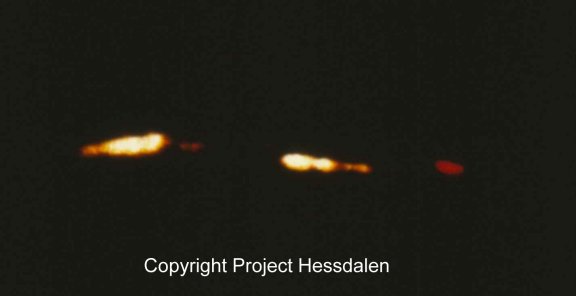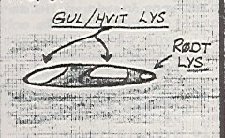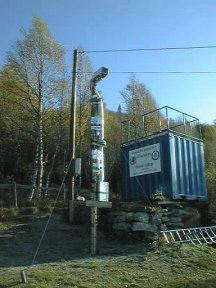Hessdalen
Project Hessdalen acquired its name from the small valley of Hessdalen, which is situated just north-north-west of the town of Roeros in Norway. If you travel 40 km north on Route 30,
from Roeros towards the city of Trondheim, you come to the small village of Aalen.
From there the road leads to Hessdalen. The valley is about 15 km long in a north-south direction.
There are mountains in the east, Rognefjell in the northern part, then Stordalshogda and further south
lies Ratvollfjellet. These mountains are between 917 and 995 metres above sea level. In the west, lies the
mountain of Finnsaahoegda in the north, then Fjellbekkhogda, Baatjornhogda, and in the south is the mountain
Rohovda. These mountains are between 1063 and 1088 metres above sea level. South of the valley there are two
lakes, Herssjoen in the east and Oyungen in the west. Most of the 170 inhabitants live close to the road,
about 700 metres above sea level.
The phenomena
In December 1981 did the inhabitants start to see strange unknown lights in Hessdalen.
It was a high observation rate until the summer of 1984.
In one week there could be as many as 20 observations. Most observations were seen in the valley,
but there were also many observations in the nearby districts.
More than 85% of the observations were described only as a strong light. These lights could be anywhere.
Sometimes they were reported to be just above the roofs of houses, or just above the ground.
Sometimes they could be high up in the air. Mostly the lights were reported to be below the tops of the
mountains nearby. No one could give any explanation of these lights.
The lights could be split into three groups:
- Small, strong white or blue flashes, which could show up anywhere in the sky.
- Yellow or yellow-white lights. These lights have very often been seen in the valley, just over the roofs of houses, or even down on the ground. They could be stationary for more than an hour, move slowly around in the valley, and sometimes show large accelerations and speeds. They could also be higher up in the sky. Mostly they moved on a north/south course.
- Several lights together with a fixed distance between each other. Mostly they were a formation of three: two yellow or white lights with a red in front. Many people talked about "The Object", when they saw this type of light. These lights could move slowly around the tops of the mountains. The direction of "travel" was mostly on a north/south course.
Objects were also seen in the daytime. Sometimes a black, oval or rectangular shaped object, sometimes a cigar-shaped object and sometimes a disc-shaped object.
The "lights" were mostly seen in the autumn, winter and spring. This may be because Hessdalen is so far north that the dark nights are very long in the winter; in the summer it is light nearly the whole night long. However, there are daylight observations and they are mostly made in the summer.

Fig.1 - Three lights together
 On 18th March 1983 at 19:33,
did Leif Havik see three lights which was located on to "a black oval shaped object".
Two yellow lights at the back and one red at the front. Leif managed to take a photograph. (See fig.1).
The lights were so strong that Leif set the shutter time of the camera to 1/15 second.
The phenomenon, with these three lights, moved slowly towards north, in front of the mountain Finns�h�gda, then disappeared behind the mountain. On 18th March 1983 at 19:33,
did Leif Havik see three lights which was located on to "a black oval shaped object".
Two yellow lights at the back and one red at the front. Leif managed to take a photograph. (See fig.1).
The lights were so strong that Leif set the shutter time of the camera to 1/15 second.
The phenomenon, with these three lights, moved slowly towards north, in front of the mountain Finns�h�gda, then disappeared behind the mountain.
During the autumn, winter and spring of 1981/1982, 1982/1983 and 1983/1984 there were several hundred
observations. The newspapers reported them and a lot of people went up to that valley. Most of them went
home happy, after seeing a the phenomena.
Neither the Norwegian government nor any research institutes did anything to find out more about this
phenomenon. That is why five people started their own Project Hessdalen.
Project Hessdalen
Project Hessdalen came into being on 3rd June 1983 when people from UFO-Norway, UFO-Sweden and Foreningen for Psykobiophysic came together to discuss what to do with the activity in Hessdalen.
One of the main goals was to find out more about the phenomena in Hessdalen, and get the mainstream
scientists interested in this topic. A field investigation was prepared during the autumn of 1983.
ooperation was established with members of the Norwegian Defence Research Establishment, the University of Bergen and University of Oslo.
From 21st January 1984 to 26th February 1984 field investigations were carried out in Hessdalen. In total 40 people participated. They were equipped with cameras and located on three different sites in Hessdalen. The field work was directed from a headquarter, which was equipped with different kinds of instruments. The results from these 5 weeks of fieldwork were:
- A total of 53 sighting.
- A radar measured the distance and speed of the phenomena. The highest speed recorded was of a light travelling towards north at a speed of 30,000 km/h. The radar also captured the phenomena, when they were invisible to the human eye.
- A seismograph did not register any local seismic activity. All the recordings registered were from earthquakes from other places around the world. I think this shows quite clearly that the phenomena have nothing to do with local seismic activity.
- A magnetograph measured the changes in the magnetic field and recorded changes in the magnetic field when the phenomena showed up.
- A Geiger-counter, which measures nuclear radiation, did not show any change in the counting rate when the phenomena showed up. But this counter was far away from the phenomena. We know that radiation decreases much with distance, so if there had been any change registered, this would indicate significant radioactivity, and the phenomena would had been very dangerous. Even no radioactivity was measured, there might still have been radiation anyway, only not strong enough for the Geiger counter to pick it up.
- A IR-viewer, which detects into the infrared part of the spectrum, was not used. There were not enough people at headquarters to do the monitoring. Other instruments and cameras were used instead.
- A spectrum-analyzer measured all the frequencies between 100 KHz and 1200 MHz, and could detect any disturbances in radio or TV frequencies. There was noise sometimes. The harmonics between noise signals was 80MHz, covering the whole band. The amplitude moved up and down every 2 seconds (a frequency of about 0,5 Hz).
- A camera, with a grating in front, showed the distribution of wavelentghs of the lights. This informed us much about the origins of the lights. We managed to get three photographs which were good enough to be analysed. They showed a continuous spectrum, characteristic of a solid object; a glowing gas would show a spectrum with lines in it. That was not the case shown in our photographs.
- Perhaps the strangest observation was the tests done with a laser. Before our fieldwork, people informed us that the "light" disappeared when a strong spotlight was directed onto the "light". We wanted to test this. Instead of a spotlight, we used a He-Ne laser. When we sighted a regular flashing light travelling towards north, we directed the laser beam onto it, and it became a double flashing light. As soon as we moved the beam away, the light returned to a regular flashing light again. When we directed the beam onto it again, it started double flashing once more. We repeated this shining on and off with the laser beam 4 times while this light continued to move towards north, and every time it doubled its frequency of flashing. The second test was carried out one hour later, when a similar light was travelling towards south. The same thing was observed. This time we directed the laser beam on and off the light 5 times. 4 of those 5 times the light doubled its frequency.
One week after our test with the laser beam, a red light moved around the feet of some observers, at the ground level. It looked just like a laser similar to the one we used. It lasted only a couple of seconds, and not long enough to find out where it came from. The only source it could have come from was the sky above us.
Sometimes some of the observers felt a rocking motion, as if they were sitting in a boat on the sea. All the observers described the same wave-like motion, but the frequency each person felt was different. Such feelings may come if the brain is in a strong low-frequency EM-field. There was no instrument that could measure if such EM-field was present when this feeling was experienced.
The headquarters was located on a hill. The distance to the nearest 220V power supply was 600 m, and a 600m power cable was lying on the ground. Many times the power failed when the phenomena appeared, returning immediately after the phenomenon disappeared. This happened many times, although not every single time.
After the fieldwork in 1984 the results were discussed with mainstream scientists at different research establishments in Norway and a technical report was written in English.
 A new field work was carried out, the first part with instruments, from 12th to 28th January 1985, and the second part without instruments and in the presence of only a few observers, from 29th January to 11th February. We wanted to test if there were more observations when no instruments was present. Many people reported sighting a light just before or just after their camera was ready for use. As if the lights did not want to be captured on film. This was the reason for why we decided to undertake the field work in two periods. Unfortunately, we did not observe anything in the first period, and only one good observation in the second period.
Only one good observation during those 4 weeks was too little to draw any conclusion on our tests. Even though the weather was worse than previous years, it was obvious that the intensity of the observations was over.
A new field work was carried out, the first part with instruments, from 12th to 28th January 1985, and the second part without instruments and in the presence of only a few observers, from 29th January to 11th February. We wanted to test if there were more observations when no instruments was present. Many people reported sighting a light just before or just after their camera was ready for use. As if the lights did not want to be captured on film. This was the reason for why we decided to undertake the field work in two periods. Unfortunately, we did not observe anything in the first period, and only one good observation in the second period.
Only one good observation during those 4 weeks was too little to draw any conclusion on our tests. Even though the weather was worse than previous years, it was obvious that the intensity of the observations was over.
The work of informing the general public that the phenomenon is real, and to bring more of the mainstream scientists into the field then started. The result is presented at more than 80 lectures around the world, more than 50 TV-programs, more than 60 radio-programs, and in several books and articles.
The New Project Hessdalen
The phenomena in Hessdalen were still present. Reports were coming in. Not as much as the period between 1981 and 1984, but it was in the order of 20 observations a year. This is high enough intensity to do something more.
During a presentation of Project Hessdalen for the inhabitants of Hessdalen on 9th October 1993, a discussion started on " what to do now". We agreed to arrange a workshop in Hessdalen for the mainstream scientists. From Thursday 24th March to Saturday 26th March 1994 the "First International Workshop on the Unidentified Atmospheric Light Phenomena in Hessdalen" was held. 27 scientists from 8 different countries participated. The invitation to that workshop was mainly sent to ball lightning scientists, since this field was the only scientific field that dealed with unknown "light"-phenomena.
The workshop concluded that the phenomena is not a ball lightning and that more data are needed. The new Project Hessdalen was now located at Ostfold University College. Some students at the College started to work on setting up an automatic measuring station for collecting data, for their final thesis. It was a major work, involving several student groups working on it. The measuring station was completed in the summer of 1998.
Hessdalen Automatic Measurement Station
 Hessdalen AMS (Automatic Measurement Station) was installed in Hessdalen on 7th August 1998. It is located in a "Blue Box" north-east of Hessdalen, on the side of Rognefjell mountain. It is on Bjarne Lillevold's land. The camera is looking towards west so that the mountain Finns�h�gda can be seen.
Hessdalen AMS (Automatic Measurement Station) was installed in Hessdalen on 7th August 1998. It is located in a "Blue Box" north-east of Hessdalen, on the side of Rognefjell mountain. It is on Bjarne Lillevold's land. The camera is looking towards west so that the mountain Finns�h�gda can be seen.
Hessdalen AMS consists of two computers, one black-and-white CCD-camera, one video-recorder and one magnetometer. The camera is connected to a computer and to the video-recorder. The computer analyses the pictures from the CCD-camera every second. If there is a sudden change in the picture, compared with the previous picture, an alarm will be triggered. That alarm will start the video-recorder running for at least 15 seconds. Just after the computer has started the video-recorder, the picture is sent directly to the Internet, at address: http://www.hessdalen.org/station/alarm.shtml
This system generates a lot of false alarms, but it also receives interesting alarms. During the periode from August 1998 to January 2000, 70 interesting pictures, showing the phenomena, were collected.
Hessdalen AMS also takes a picture every hour and measures the magnetic field, these data are sent to Internet. The main page for Hessdalen AMS is: http://www.hessdalen.org/station
Further Plans for Hessdalen AMS.
Today, with only one CCD-camera, a lot of false alarms are detected, and it is impossible to calculate the distance of what is detected. By putting up one more camera it will be possible to calculate the distance, and it might even be possible to see a 3D-picture of the phenomena. It will also give a better detection, because the sensitivity of the system can be increased. With only one camera, the station cannot be set at a high sensitivity, because it would then trigger off too many false alarms. We know that at today's sensitivity not all phenomena are detected. There have been observations which have not been detected by the station.
The station records a detection if the phenomenon moves at a high enough speed and is strong enough in intensity. Both these two parameters can easily be changed in the software.
We also want to put more cameras up, so that other areas of the valley can be seen. Today only one part of the valley is covered.
More instruments are also needed. A radar can detect the distance and speed, which can then be compared with the distance that the optical system calculates, making this data more reliable. A radar might also detect "invisible" phenomena.
All this costs much money. At present much time and effort are spent on raising enough money to run today's system. If you can make a contribution, whatever the amount, you will be helping in finding out more about the phenomena.
11 May 2000 - updated 11 November 2003
Erling P. Strand
Assistant Professor
�stfold University College
P.O.Box 1192, Valaskjold
N-1705 Sarpsborg, Norway
Phone: +47 6910 4032 Phone at home: +47 6916 9600
Fax: +47 6910 4002 Fax at home: +47 6916 8018
Mobile: +47 922 68 256
|